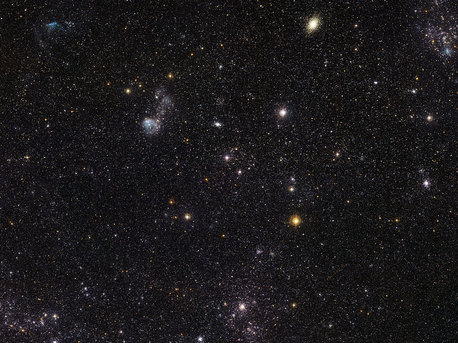Evolution of Galaxies
A Cosmic Zoo in the Large Magellanic Cloud
 © ESO
|
A Cosmic Zoo in the Large Magellanic Cloud
This image is a mosaic of four pictures from the Wide Field Imager on the MPG/ESO 2.2-metre telescope at the La Silla Observatory in Chile. The image covers a region of sky more than four times as large as the full Moon. The huge field of view of this camera makes it possible to see a very wide range of objects in the LMC in a single picture, although only a small part of the entire galaxy can be included. Dozens of clusters of young stars can be seen as well as traces of glowing gas clouds. Huge numbers of faint stars fill the image from edge to edge and in the background, more galaxies, far beyond the LMC, are visible.
Globular clusters are collections of hundreds of thousands to millions of stars bound by gravity into a roughly spherical shape just a few light-years across. Many clusters orbit the Milky Way and most are ancient, over ten billion years old, and composed mainly of old red stars. The LMC also has globular clusters and one is visible as the fuzzy white oval cluster of stars in the upper right part of the image. This is NGC 1978, an unusually massive globular cluster. Unlike most other globular clusters, NGC 1978 is believed to be just 3.5 billion years old. The presence of this kind of object in the LMC leads astronomers to think that the LMC has a more recent history of active star formation than our own Milky Way.
As well as being a vigorous region of star birth, the LMC has also seen many spectacular stellar deaths in the form of brilliant supernova explosions. At the top right of the image, the remnant of one such supernova, a strangely shaped wispy cloud called DEM L 190, often also referred to as N 49, can be seen. This giant cloud of glowing gas is the brightest supernova remnant in the LMC, and is about 30 light-years across. At the centre, where the star once burned, now lies a magnetar, a neutron star with an extremely powerful magnetic field. It was only in 1979 that satellites orbiting Earth detected a powerful gamma-ray burst from this object, drawing attention to the extreme properties of this new class of stellar exotica created by supernova explosions.
This part of the Large Magellanic Cloud is so packed with star clusters and other objects that astronomers can spend entire careers exploring it. With so much activity, it is easy to see why astronomers are so keen to study the strange creatures in this heavenly zoo.
source: Eurpean Southern Observatory (ESO)
Evolution of Galaxies
A Cosmic Zoo in the Large Magellanic Cloud
 © ESO
|
A Cosmic Zoo in the Large Magellanic Cloud
This image is a mosaic of four pictures from the Wide Field Imager on the MPG/ESO 2.2-metre telescope at the La Silla Observatory in Chile. The image covers a region of sky more than four times as large as the full Moon. The huge field of view of this camera makes it possible to see a very wide range of objects in the LMC in a single picture, although only a small part of the entire galaxy can be included. Dozens of clusters of young stars can be seen as well as traces of glowing gas clouds. Huge numbers of faint stars fill the image from edge to edge and in the background, more galaxies, far beyond the LMC, are visible.
Globular clusters are collections of hundreds of thousands to millions of stars bound by gravity into a roughly spherical shape just a few light-years across. Many clusters orbit the Milky Way and most are ancient, over ten billion years old, and composed mainly of old red stars. The LMC also has globular clusters and one is visible as the fuzzy white oval cluster of stars in the upper right part of the image. This is NGC 1978, an unusually massive globular cluster. Unlike most other globular clusters, NGC 1978 is believed to be just 3.5 billion years old. The presence of this kind of object in the LMC leads astronomers to think that the LMC has a more recent history of active star formation than our own Milky Way.
As well as being a vigorous region of star birth, the LMC has also seen many spectacular stellar deaths in the form of brilliant supernova explosions. At the top right of the image, the remnant of one such supernova, a strangely shaped wispy cloud called DEM L 190, often also referred to as N 49, can be seen. This giant cloud of glowing gas is the brightest supernova remnant in the LMC, and is about 30 light-years across. At the centre, where the star once burned, now lies a magnetar, a neutron star with an extremely powerful magnetic field. It was only in 1979 that satellites orbiting Earth detected a powerful gamma-ray burst from this object, drawing attention to the extreme properties of this new class of stellar exotica created by supernova explosions.
This part of the Large Magellanic Cloud is so packed with star clusters and other objects that astronomers can spend entire careers exploring it. With so much activity, it is easy to see why astronomers are so keen to study the strange creatures in this heavenly zoo.
source: Eurpean Southern Observatory (ESO)






